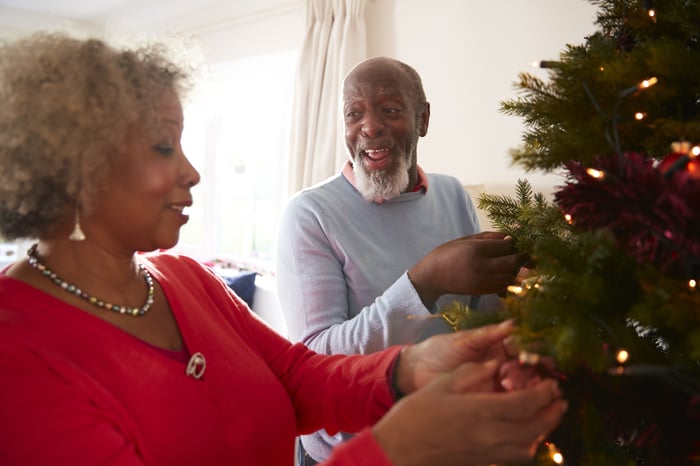
Whether your musical tastes run to Bing Crosby, Bon Jovi, Elvis, or the Eagles, the song “Home for the Holidays” is a staple of the season. But in the wake of the COVID-19 pandemic, the song seems even more poignant. What can you do when being home for the holidays puts seniors and other vulnerable family members at risk?
The Centers for Disease Control and Prevention (CDC) recently noted, “Celebrating virtually or with members of your household (who are consistently taking measures to reduce the spread of COVID-19) poses the lowest risk for spread.” Big family gatherings may have to wait until next year, but you can still celebrate safely. Here at Episcopal Church Home in Louisville, KY, we’ve identified some simple ways you can connect during the holidays — whether you live near or far.
5 Ways to Bring Your Family Together — Virtually
Leading health experts have warned that even small indoor family gatherings can lead to a rise in COVID-19 infections. With temperatures dropping around the country, outdoor gatherings are not a practical alternative for Thanksgiving, Christmas, Hanukkah, or even Festivus (for you Seinfeld fans). What can you do instead? Collaborating on Thanksgiving dinner is an excellent way to stay engaged — and these tactics will also work for the many holiday festivities that follow in December and January.
1. Have dinner delivered to senior loved ones.
Thanksgiving with all the fixings is not for the faint of heart. If you’d like to give seniors the joys of a celebratory meal without all the effort, you can have dinner delivered to them. If you’re looking for traditional Thanksgiving fare, you can check out a meal delivery service like Blue Apron or a restaurant like Bob Evans, which offers a complete Thanksgiving meal to go. This option is appreciated throughout the holiday season, whether you live near-by or across the country, thanks to apps like DoorDash, which allow you to “gift” a meal for any occasion.
2. Organize a dish exchange to reduce the amount of cooking everyone does.
If your extended family lives nearby, you may be accustomed to sharing the cooking responsibilities by carrying in a favorite side dish or dessert. That tradition doesn’t need to end; it just needs to be reimagined.
Work together to plan the menu and divvy up the dishes among yourselves. Each household can then fix their portion of the meal, dividing servings into disposable containers for each family. On Thanksgiving morning, arrange to gather at a central location — ideally outdoors, wearing masks — to distribute the pre-portioned servings. Afterward, you can all enjoy the family favorites from your individual households.
3. Consider a recipe exchange if the distance is an issue.
We all have dishes that are family traditions. If Thanksgiving isn’t Thanksgiving without mom’s stuffing or grandma’s pumpkin pie, it’s time to pass the torch — or at least share the recipe.
Have everyone vote for must-have recipes and then send the recipes via email so that everyone in the family can recreate their favorite dishes. Take plenty of pictures to share afterward. Don’t forget to document memorable failures too. It may be hard to see the humor in an overdone turkey or a collapsed pumpkin pie, but family has a way of turning those kinds of moments into laughter-filled memories.
4. Go "old school" with snail mail.
This year, political campaigns inundated mailboxes around the country with postcards and appeals, not to mention a steady diet of junk mail. Isn’t it time to make ‘getting the mail’ something to which to look forward?
Send your senior loved ones hand-written notes expressing your gratitude and love. Make the annual holiday letter a family affair by having each household member participate in some way. For example, invite younger children to draw or color a picture. Encourage older children and young adults to write about or share a picture of a favorite memory from the year.
5. Arrange a video chat.
When arranging virtual calls, keep in mind that your senior loved ones may find it confusing to get started. Before jumping into a group call, consider these tips:
- Test a few apps and go with the most user-friendly option. For iPhone or iPad users, Facetime is a natural choice, and you can include multiple people on the call, as long as they are also iPhone/iPad users. For families that aren’t all on the same device, consider Google Hangouts or a group call app like Zoom or Microsoft Teams.
- If you’re giving instructions over the phone or in person, make sure you provide enough detail that you don’t add to their confusion. For example, don’t just say ‘click on the link’; say ‘move your arrow to the top right corner and click on the blue link.’
- Ask them to repeat the step immediately after they do it. Repetition helps reinforce the new process.
If all else fails, consider getting your senior loved ones a video chat device like the Grandpad tablet, the Echo Show from Amazon, Portal from Facebook, or many other options.
We’ve already seen a significant spread of COVID-19 from traditional family gatherings. Weddings, funerals, birthday parties, and holiday celebrations — all pose an infection risk for attendees. But that doesn’t mean you can’t make this holiday season one to remember. With the right approach, you can maintain meaningful connections while protecting vulnerable seniors in your life.











